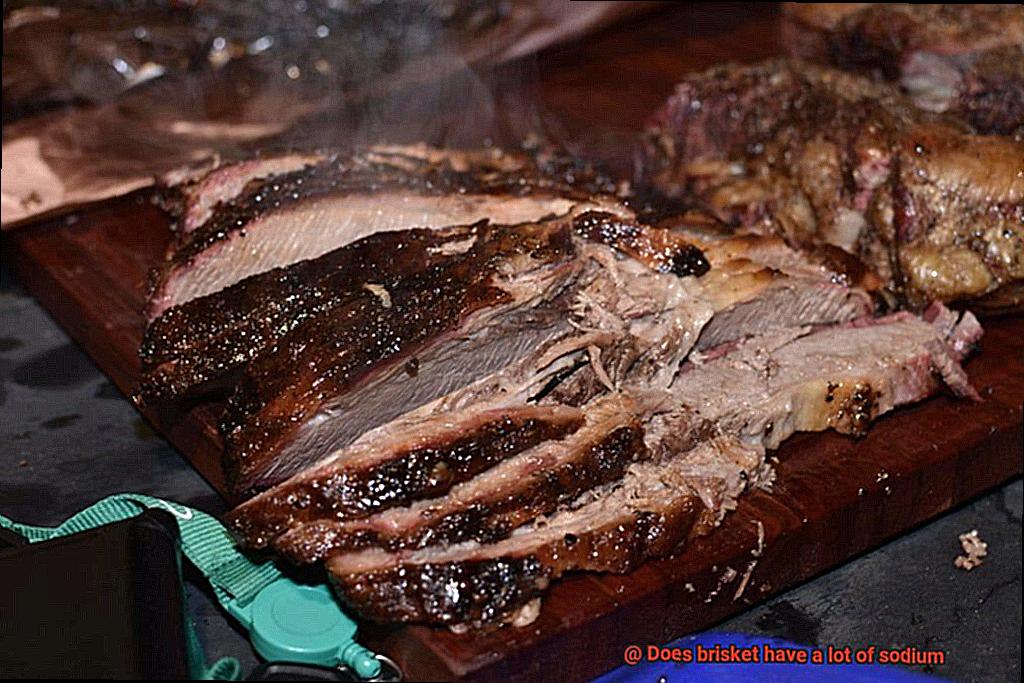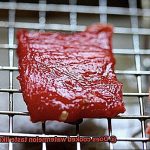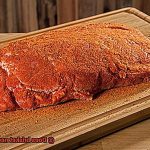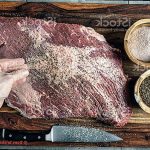Have you ever indulged in a juicy, mouth-watering brisket and wondered how much sodium you just consumed? It’s a question that many of us may not even consider, but it’s an important one, especially if you have health concerns.
Brisket is a meat that’s loved by many for its rich flavor and tenderness, but it’s also infamous for being high in fat and calories. However, what about its sodium content? Does brisket have a lot of sodium, and if so, how much is too much? In this blog post, we’ll delve into the details to answer these questions and more.
Firstly, let’s explore what sodium is and why it matters for our health. Then we’ll take a closer look at how much sodium is typically found in brisket compared to other popular cuts of meat. We’ll also examine how different cooking methods can impact the levels of sodium in your brisket.
But don’t worry. We won’t leave you hanging without some tips on how to reduce your sodium intake while still enjoying this delectable meat. Whether you’re a seasoned brisket enthusiast or someone looking to stay mindful of their salt intake, this blog post has something for everyone.
So, grab yourself a refreshing glass of water (trust us, you’ll need it) and get ready to dive into the salty world of brisket with us.
Contents
What is Brisket?
Brisket is a beloved cut of beef that has been a staple in many cultures, especially in Texas where it is considered a delicacy. The lower chest area of the cow is where brisket comes from, making it a tough and fatty cut of meat that requires slow cooking at low temperatures to break down the connective tissues and make it tender and juicy. The meat is rich in flavor and can be seasoned with various spices and sauces to enhance its taste.
There are two types of brisket: the point cut and the flat cut. The point cut is more fatty and flavorful, while the flat cut is leaner and easier to slice. Both cuts can be used for smoking, braising, or roasting, depending on personal preference. Brisket is often served thinly sliced with sides such as coleslaw, potato salad, or baked beans.
Now, whether brisket contains a lot of sodium is a question that has left people wondering about its potential health effects. The answer isn’t straightforward, but let’s break it down.
On average, a 3-ounce serving of cooked fresh beef brisket contains around 45 milligrams of sodium. This amount is considered relatively low compared to other types of meat. However, how you prepare your brisket can significantly affect its sodium content. For example, corned beef brisket has a much higher sodium content than fresh beef brisket.
Similarly, marinating your brisket in high-sodium sauce or seasoning blends or using pre-packaged seasoning mixes or rubs can increase the overall sodium content of your dish.
So, if you want to enjoy this delicious meat without worrying about its impact on your health, choose fresh beef brisket and use low-sodium seasonings and cooking methods.
What is the Sodium Content in Brisket?
Brisket is a mouth-watering cut of beef that is popularly used for barbecuing and smoking. However, many people have raised concerns about its sodium content. As an expert on the subject, I can say that the sodium content in brisket can vary depending on factors such as cooking methods and seasoning used.
If you’re a health-conscious individual, you should know that consuming too much sodium can lead to serious health problems. A plain, unseasoned brisket will have a lower sodium content compared to one that has been heavily seasoned or marinated in a salty solution.
On average, a 3-ounce serving of brisket contains around 240 milligrams of sodium. This may seem like a moderate amount, but if you consume it in larger portions or alongside other salty foods, the sodium content can quickly add up. Processed brisket products, such as deli meat or pre-packaged meals, are even more concerning as they contain higher levels of sodium due to added preservatives and flavorings.
However, don’t let this discourage you from enjoying your beloved brisket. With mindful consumption and some healthy cooking methods and seasonings, you can still include it in your balanced diet. Opt for plain, unseasoned brisket whenever possible and choose low-sodium options for processed products.
Factors that Affect the Sodium Content in Brisket
Brisket is a beloved cut of beef known for its tenderness and rich flavors. However, the sodium content in brisket can vary greatly depending on several factors. As an expert on the topic, I’m here to share some fascinating insights on the factors that affect the sodium content in brisket.
Firstly, let’s talk about the way brisket is prepared. If you’re purchasing commercially prepared or pre-packaged brisket, be aware that it often contains high levels of sodium. This is due to salt being used as a preservative and flavor enhancer in many processed foods, including brisket. Additionally, restaurants and BBQ joints may add extra salt or seasoning during preparation. To reduce your sodium intake, opt for plain, unseasoned brisket whenever possible.
Next up, let’s examine the cut of meat itself. Brisket is composed of two parts – the flat and the point. The point tends to have more fat, which can lead to higher sodium levels since salt is often used to preserve and enhance the flavor of fatty meats. So, if you’re looking to reduce your sodium intake, choosing the flat may be a better option.
The type of seasoning used on the brisket also plays a significant role in its sodium content. Dry rubs or marinades that are high in salt can significantly increase the sodium levels in the final dish. Consider using lower-sodium seasonings or making your own spice blends at home to control the amount of salt used.
Lastly, let’s look at how cooking methods impact sodium content. Brisket that is smoked or slow-cooked over a long period of time tends to have a more intense flavor, which can lead to a higher perceived saltiness. Additionally, some cooking methods may require the use of additional salt or seasoning to achieve desired results. Experiment with different cooking techniques and try to enhance the flavor of your brisket without relying on excessive salt.
Types of Brisket and Their Sodium Content
In this article, we’ll delve deeper into the different types of brisket and their sodium content, so you can make an informed decision when choosing which one to cook or grill.
Traditional Brisket: The Salty One
The most common type of brisket is the traditional or packer brisket. This cut of meat comes from the lower chest of the cow and contains both the point and flat muscles. It is typically cured with a salt-based brine which gives it a signature salty flavor.
As a result, traditional brisket is high in sodium content. A 3-ounce serving of traditional brisket contains around 550 milligrams of sodium.
Lean Brisket: The Healthier Option
For those looking for a healthier option, lean brisket is the way to go. This cut of meat comes from the same area of the cow as traditional brisket but has less fat and is not cured with a salt-based brine. Instead, it is seasoned with herbs and spices, giving it flavor without adding sodium. A 3-ounce serving of lean brisket contains only around 50 milligrams of sodium.
Wagyu Beef Brisket: The Tender But Salty One
Wagyu or Kobe beef brisket comes from a specific breed of cattle known for its marbled meat. This type of brisket is tender and juicy, but also high in fat and sodium. A 3-ounce serving of Wagyu beef brisket contains around 480 milligrams of sodium.
Flat Cut Brisket: The Leaner Option
In addition to the different types of meat, there are also different cuts of brisket to choose from. The flat cut, also known as the first cut, is leaner and has less fat than the point cut. Choosing a flat cut brisket can help reduce your sodium intake, as there is less natural sodium from the meat itself. This is because the flat cut has less fat than the point cut, which means there is less marbling and thus, less sodium.
Seasonings and Marinades: The Sodium Culprits
Finally, it’s worth noting that the way you prepare your brisket can significantly affect its sodium content. If you choose to marinate your brisket in a high-sodium sauce or seasoning blend, this can increase its overall sodium content.
Similarly, if you use a pre-packaged seasoning mix or rub, these often contain high amounts of salt and can increase the sodium content of your dish. Choosing low-sodium seasonings and marinades is an easy way to decrease the sodium content of your brisket.
Preparing Brisket and its Impact on Sodium Content
As an expert on preparing brisket and its impact on sodium content, I have some tips to help reduce the overall sodium levels without sacrificing flavor.
Firstly, let’s talk about rubs and marinades. Many commercial options are loaded with salt, which can quickly add up and contribute to high levels of sodium in your dish. Instead, try making your own rub or marinade using herbs, spices, and other flavorful ingredients. Not only will it enhance the taste of the meat without adding extra sodium, but it’s also easy to make.
Another way to lower sodium content is by trimming excess fat from the meat before cooking it. This not only helps reduce overall sodium levels but also creates a leaner and healthier meal. Slow cooking brisket at a low temperature helps break down the proteins in the meat, resulting in a tender and juicy texture without adding extra salt.
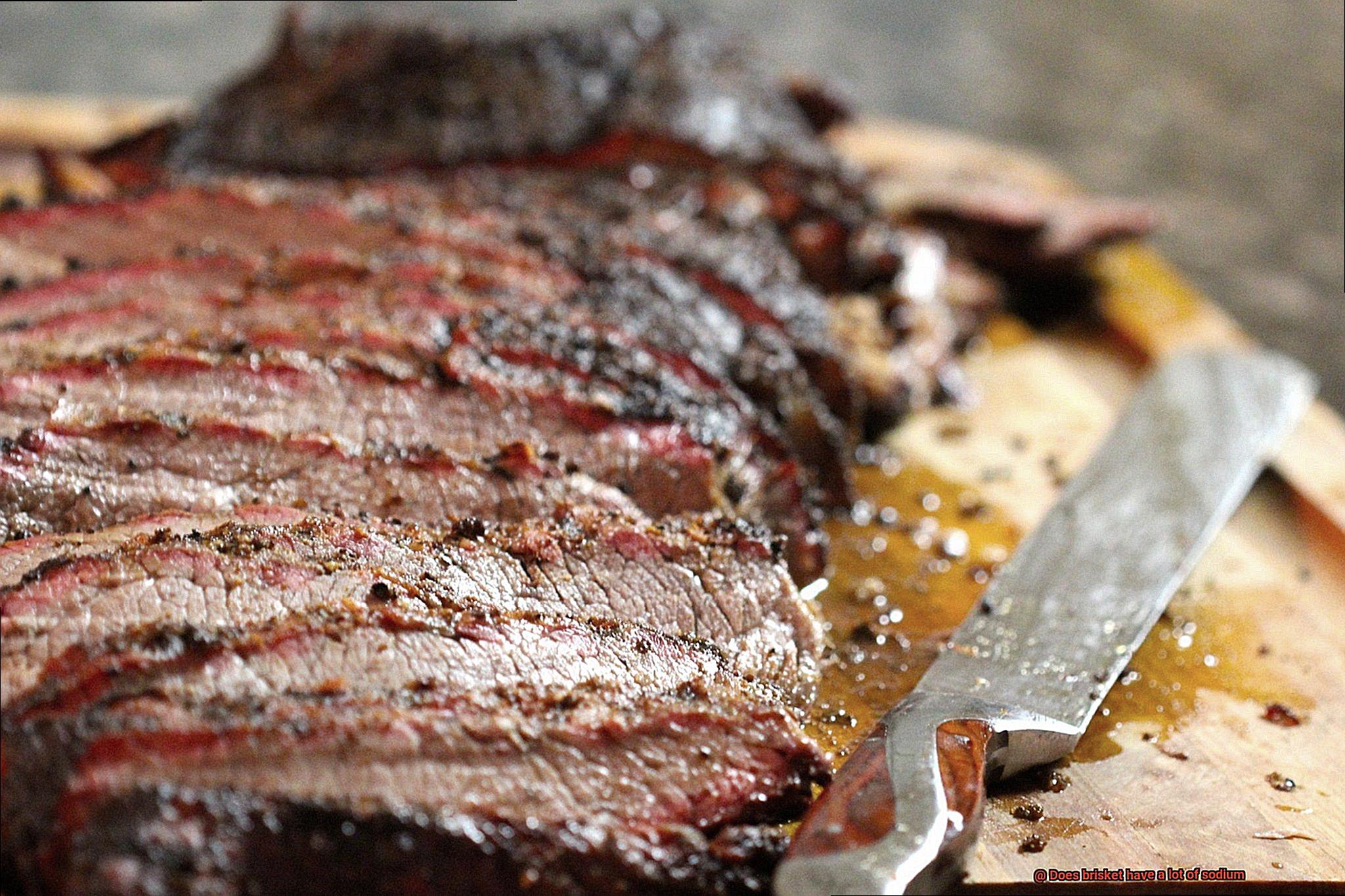
But that’s not all. Portion control is also crucial when it comes to reducing overall sodium intake. By keeping serving sizes reasonable and pairing brisket with low-sodium sides such as vegetables or whole grains, you can create a balanced meal that won’t overload your sodium intake.
Low-Sodium Alternatives to Brisket
As an expert in the field, I have researched and compiled some tasty options that are sure to satisfy your cravings.
First up is turkey breast – a lean protein that can be grilled or smoked just like brisket. Its mild flavor profile makes it a versatile option that’s perfect for any occasion. Pork tenderloin is another delicious alternative with a similar texture and flavor to brisket, but with significantly less sodium. For beef lovers, the tri-tip cut is a great choice. It’s lean, flavorful, and can be marinated and grilled to perfection.
If you’re a fan of chicken, chicken thighs are a great alternative to brisket. They’re rich in flavor and can be cooked in a variety of ways. And for those who prefer plant-based options, tofu and seitan are both excellent choices. They have a meaty texture that can absorb flavors well, making them perfect for creating savory dishes.
When preparing these low-sodium alternatives, it’s crucial to pay attention to the seasoning and marinades used. Opting for fresh herbs, citrus juices, and other natural flavors can enhance the taste without adding excess sodium. Using low-sodium soy sauce or tamari can also help reduce sodium levels in marinades without sacrificing taste.
Health Benefits of Eating Low-Sodium Brisket
There are ways to prepare this mouth-watering meat without compromising your health goals. In fact, consuming low-sodium brisket can provide numerous health benefits that you may not have even considered before.
First and foremost, brisket is an excellent source of protein. Protein is necessary for building and repairing muscles, and it also keeps you feeling full and satisfied after a meal.
Additionally, brisket is rich in iron, which is crucial for maintaining healthy blood cells and preventing anemia. These are just some of the essential nutrients that you can get from consuming this delicious meat.
Now, let’s talk about reducing the sodium content in brisket. One way to do this is by opting for lean cuts of meat and preparing it using low-sodium seasonings. Instead of using pre-packaged seasoning blends that may be high in sodium, try making your own blend using herbs and spices like garlic, onion powder, paprika, and black pepper. This will give your brisket a burst of flavor without the added sodium.
Another great way to reduce sodium content is by choosing cooking methods that don’t require added salt.
For instance, instead of brining or marinating the meat in a salt solution, try cooking it in a slow cooker with onions, carrots, and celery for added flavor without the extra sodium.
It’s important to note that brisket also contains other essential nutrients like zinc, vitamin B12, and niacin. By choosing lean cuts of meat and preparing it using low-sodium seasonings and cooking methods, you can enjoy all of these health benefits without worrying about consuming too much sodium.
IRULwRFSa60″ >
Conclusion
In summary, brisket is a delectable meat that has won the hearts of many for its succulent taste and tenderness. However, with its high fat and calorie content, concerns about its sodium levels have arisen. A 3-ounce serving of cooked fresh beef brisket typically contains around 45 milligrams of sodium – a relatively low amount compared to other meats. Nevertheless, how you prepare your brisket can significantly affect its sodium content.
Factors such as cooking methods, seasoning used, and the type of brisket can all impact the sodium levels in your dish. If possible, choosing plain, unseasoned brisket and opting for low-sodium options for processed products can help reduce your sodium intake.
Moreover, various low-sodium alternatives to brisket provide similar flavors and textures without compromising your health goals. These include turkey breast, pork tenderloin, tri-tip cut beef, chicken thighs, tofu, and seitan.
Choosing lean cuts of meat and preparing them with natural flavors like herbs and spices instead of pre-packaged blends or marinades high in salt content can help you enjoy this mouth-watering meat while reaping its numerous health benefits.

